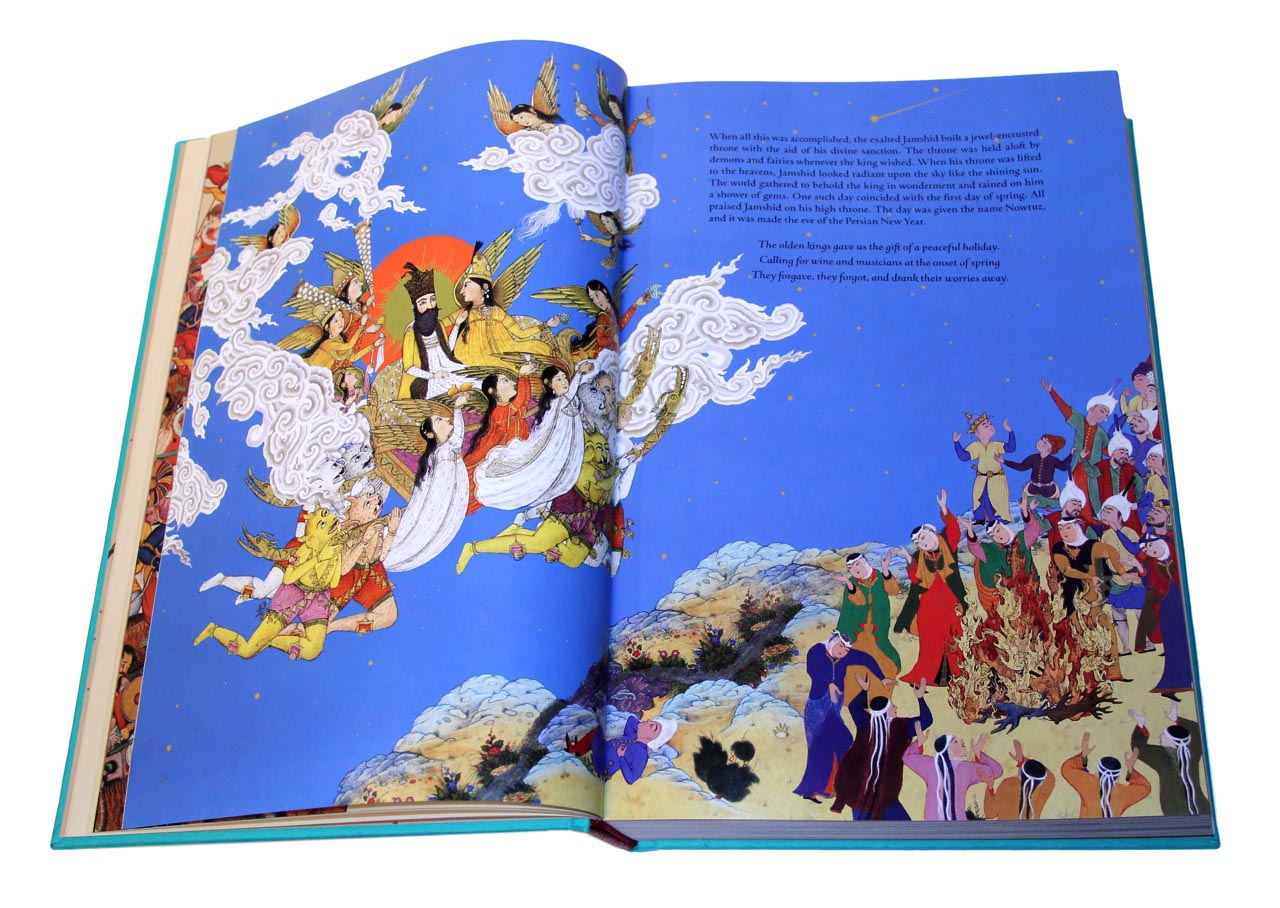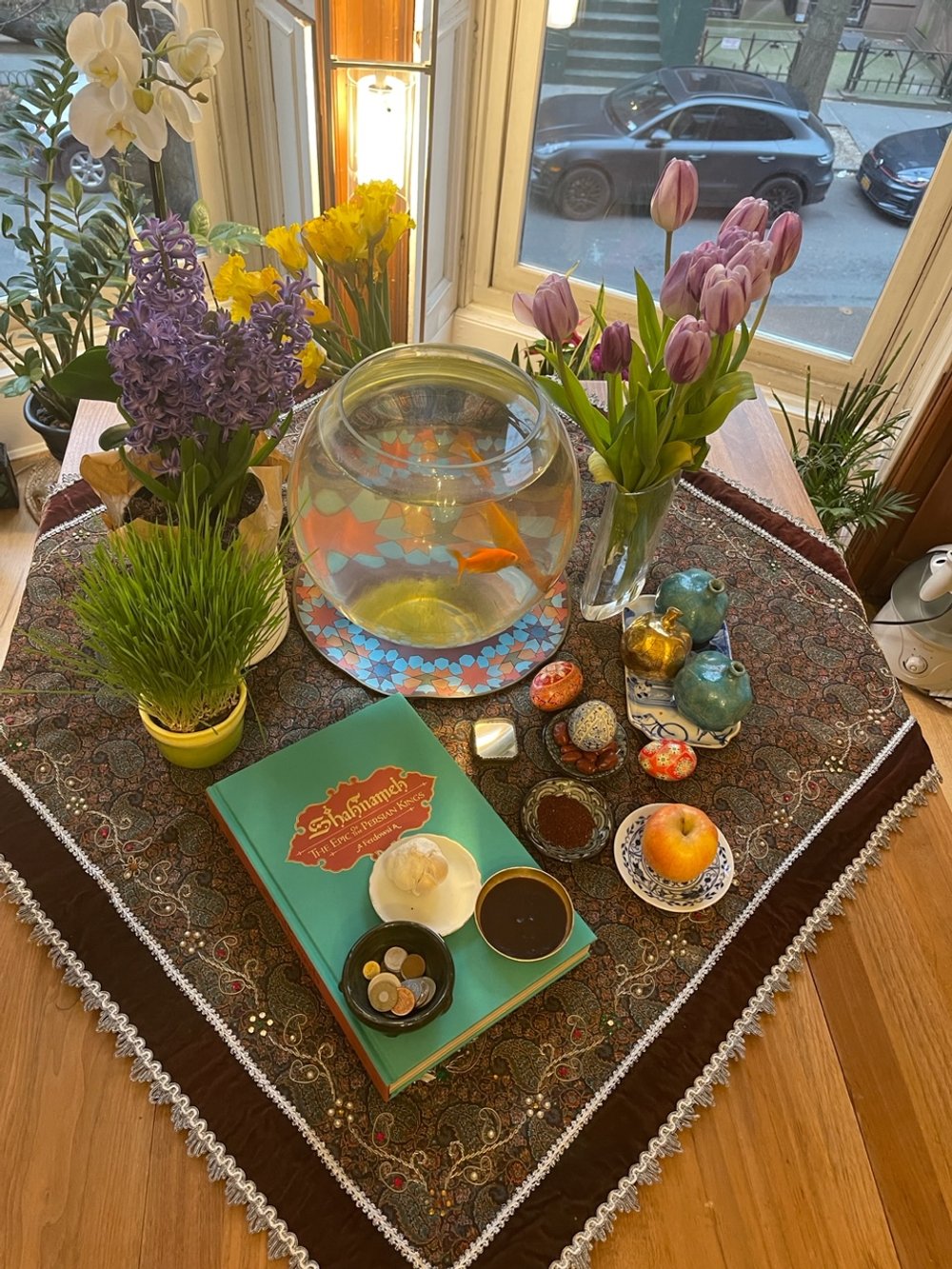Are you ready for winter to be over and done with? What’s often known as Persian New Year celebrates the first day of spring, and goes back at least three thousand years. Nowruz—spelled in a number of different ways, including Nowrooz, Novruz, and Nauryz—means “new day,” and has its origins in Zoroastrian religion and culture. And its connections to the Shahnameh are also strong.
King Jamshid and the Flying Chariot of Nowruz
In Ferdowsi’s tale, King Jamshid topped off a list of impressive accomplishments—huge building projects, massive mining operations, the production of perfumes, a program of shipbuilding and seafaring, the organization of social and professional classes, and even the introduction of medicine into the world—with human flight. Using the demons his father had subjected for his labor force, Jamshid had them build an elaborate chariot, and then take him on a tour of the skies in it. His most memorable voyage took him to Babel. On that journey, the carriage, with its king looking down from it and its supernatural creatures propelling it, was such a sight that people gathered to look up as it passed overhead. That chariot ride took place on the first day of spring, which was known thereafter as Nowruz.
But it wasn’t just that event that marks the arrival of spring; in the Shahnameh’s account, Jamshid also instituted Chaharshanbeh-Suri, which takes place the Wednesday before Nowruz. One of the most common aspects of this “red” or “ruddy” Wednesday is seeing people jump over small fires. It’s a way not only of greeting longer days and light gaining ground over the dark of winter, but also of letting go of all the weight of the past year, leaving everyone ready for a fresh start in the new one. Shouting “Zardi-ye man az toh, sorkhi-ye toh az man!” in the process, jumpers are offering their “yellow,” or any of the past year’s illnesses, in exchange for the fire’s “red,” its health and wellbeing in the new year. And along with fireworks being set off, there’s often a Halloween-like aspect to Chaharshanbeh-Suri, with children dressing up and going around the neighborhood making a racket with spoons and kitchenware as they ask for treats at people’s homes.
The new year is celebrated over thirteen days, with different observances, such as Red Wednesday, happening at various points throughout that period. You might see men in red clothing, dressed as the figure known as Haji Farouz, going through the streets singing songs and playing his tambourine—or his older companion, Amu Nowruz or Baba Nowruz, with his white beard and cap. Before the arrival of the spring equinox, families also visit cemeteries and tidy the graves, leaving behind food and flowers. And between Red Wednesday and Nowruz, if spring cleaning hasn’t already gotten underway, this is the chance to get to it, literally and figuratively sweeping out the old and welcoming in the new—and probably buying some new clothes in the process. In some places, like Azerbaijan, celebrants get a whole month’s worth of Wednesdays to prepare for the new year.
Amu Nowruz takes a break in Tehran.
CC BY 4.0 image courtesy Tasnim News Agency and Wikimedia Commons
Celebrating Persian New Year around the Table
At Nowruz, family and friends come together around the table that usually features at least the “seven S’s,” or “haft seen:” items that begin with the letter S and are usually linked to the themes of renewal and growth. The items placed on the table will probably differ, depending for one thing on one’s religion—but some of the more common are sprouts, apples, herbs, garlic, flowers, and coins. Don’t be surprised if you see some goldfish in a bowl, representing new life; or a mirror, a reminder of the need for self-reflection. And if you enjoy another story about Jamshid, you might also include plenty of sweets in your haft seen spread: among all his other exploits, one tradition has the king discovering sugar, after taking a taste of the sap he saw on sugar cane.
A haft seen spread with Shahnameh
Sizdah Bedar marks the end of the new year’s season, wrapping up the thirteen days of celebration. On this day, it’s time to get outside and enjoy the weather—in fact, it would be bad luck to stay cooped up inside. Taking the sprouts that were included in the haft seen spread with them, families head outside for a picnic. Those sprouts are tossed into a river or otherwise scattered: a final chance to get the last remnants of the old year out of the house.
When to Celebrate Nowruz
Since 2010, the United Nations has officially recognized March 21 as International Nowruz Day. And as use of the word “international” indicates, celebration of the holiday isn’t limited to present-day Iran; you’ll find people celebrating Nowruz all over the world. The White House has celebrated Nowruz on its own since 2015.
President Biden and First Lady Jill Biden Marking Nowruz
Epilogue: What Happened to Jamshid After Nowruz?
According to the Shahnameh, Jamshid did quite a bit for the world—and for three hundred years, everybody respected his judgment and wisdom, and his subjects enjoyed a peaceful existence. But the king’s glory eventually went to his head, making him brag about everything he’d done, always reminding people how much they owed to him. Once he started tooting his own horn, it took just under twenty-five years for all of his advisors and followers to desert him. All of his authority gone and unrest starting to grow, the great king finally had to flee—and when Jamshid’s successor Zahhak found him a century later near the Sea of China, he sawed him in two.
King Jamshid in his good days. Portrait by Mihr ‘Ali.
Public domain image courtesy Sotheby’s and Wikimedia Commons.
More Ways to Celebrate Persian New Year
There’s so much more to know about Nowruz! Check out the links below for more traditions, stories, and ways to celebrate Persian New Year.
Need some ideas for celebrating Nowruz? The Smithsonian Museum features downloadable puzzles, puppets, crowns, and coloring books for the holiday—and their related videos also include the Shahnameh Project’s very own shadow puppet performance of Zahhak!
K. E. Eduljee provides a thorough examination of Nowruz, along with pictures of different families’ tables, and even some recipes used in different parts of the world to celebrate the holiday.
Want to know how Nowruz is celebrated in different parts of the world? Head to UNESCO’s Silk Roads Programme site to learn about poetry recitals, singing, sporting events, and more!
Happy new year! In 2020, Iranian singer Aidin Tavassoli made sure as many people as possible knew how to wish each other a happy new year. Tavassoli’s Instagram video features him singing the greeting in twenty-two languages. And if you’d like to learn a few Persian-language greetings, head over to Chai and Conversation for some helpful phrases.






